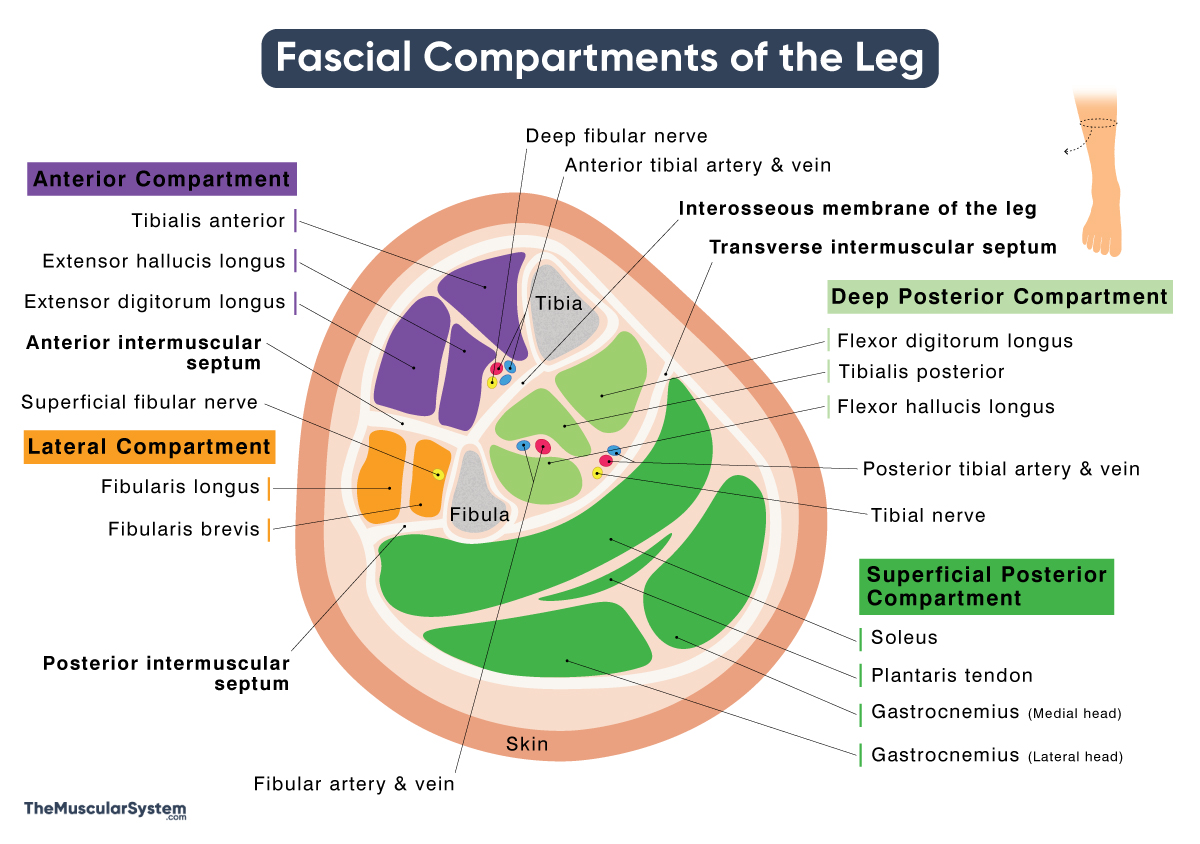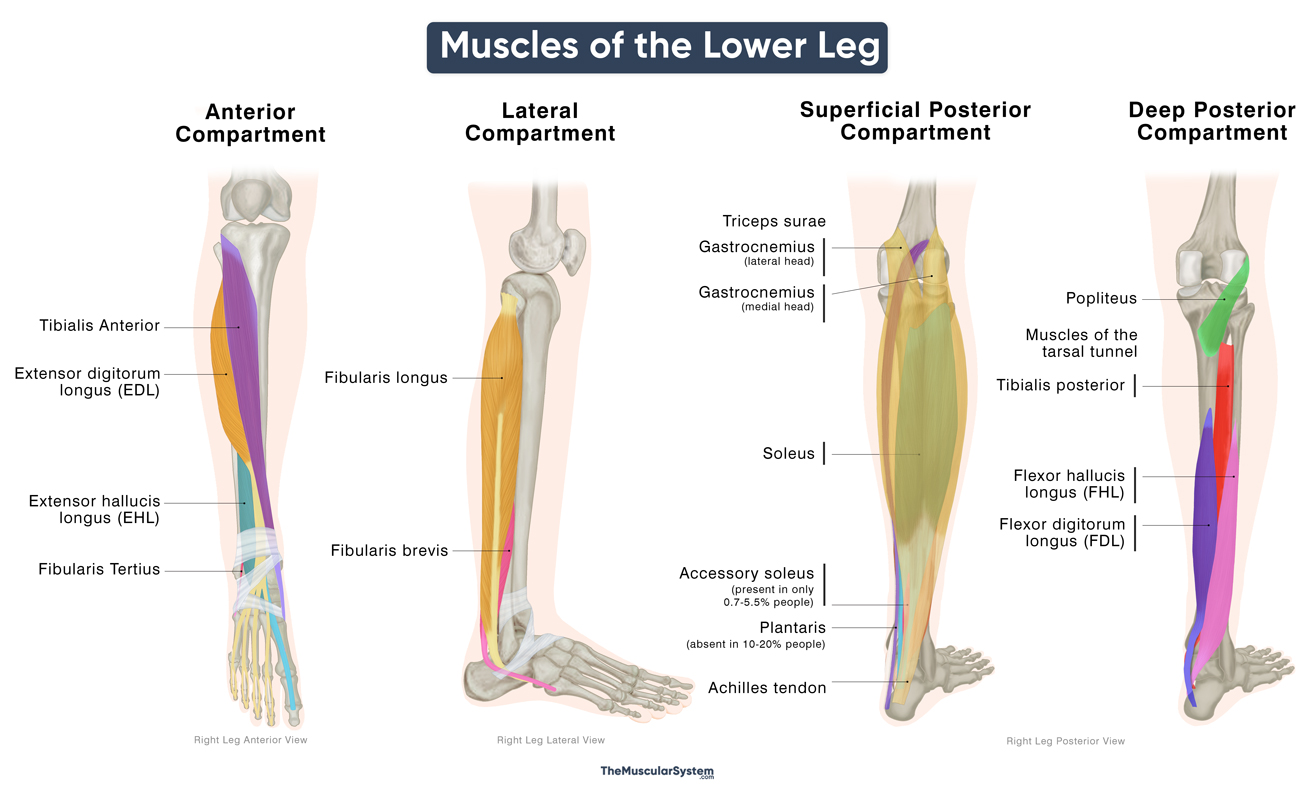Lower Leg Muscles
The leg, or lower leg, is the part of the lower limb that extends from the knee to the ankle. Some of the most powerful and vital muscles are located in this region, each with specialized roles in moving the foot and toes. Together, they control actions such as dorsiflexion, plantarflexion, inversion, and eversion, which are essential for walking, running, and maintaining balance.
Fascial Compartments of the Lower Leg
The lower leg region is separated into the anterior, lateral, and posterior compartments, with the posterior compartment being further divided into the superficial and deep groups. The compartments are separated from each other by these fascial layers of the leg:
- Anterior intermuscular septum: Separates the anterior and lateral compartments
- Posterior intermuscular septum: Separates the lateral and posterior compartments
- Transverse intermuscular septum: Separates the superficial and deep posterior compartments
- Interosseous membrane of the leg: Separates the posterior and anterior compartments
All these compartments are covered on their exterior side by the deep fascia of the leg, which is a continuation of the
There are 13 muscles in the lower leg, one of which may or may not be present in some people. These are distributed among the four compartments based on their location in the leg.
Muscles in the Anterior Compartment of the Leg
These muscles are located at the front of the leg, below the knee. They primarily help with dorsiflexion of the foot, meaning pulling the foot upward toward the shin, and extension of the toes.
Innervation: Deep fibular nerve
Blood supply: Anterior tibial artery
Muscles in the Lateral Compartment of the Leg
These lie on the lateral or outer side of the leg, running from below the knee to the foot. They are the primary muscles for eversion of the foot, helping to stabilize the foot and leg, and distribute the body’s weight during standing, walking, and other movements.
Innervation: Superficial fibular nerve
Blood supply: Fibular artery
Muscles in the Posterior Compartment of the Leg
The muscles in the posterior compartment are primarily responsible for plantar flexion, which means pointing the toes downward, like when standing on your tiptoes. It also includes the muscles that flex all the toes. Their actions are typically antagonistic to the actions of the anterior compartment muscles.
Superficial Posterior Compartment
These muscles form the bulk of the calf along the back and inner side of the leg. They are the primary muscles responsible for plantarflexion of the foot (pointing the toes downward) and play a vital role in pushing the body forward while walking, running, or jumping.
- Triceps surae
- Plantaris (may be absent in 10-20% of the population)
The tendons of the gastrocnemius and soleus muscles merge and insert as a thick common tendon at the back of the heel. This tendon, known as the Achilles tendon, is the thickest and strongest tendon in the human body.
A small accessory muscle, the accessory soleus, may be present in about 0.7-5.5% of people.
Innervation: Tibial nerve
Blood supply: Sural artery (primary), femoral artery, and posterior tibial artery.
Deep Posterior Compartment
These muscles lie deep to the superficial posterior muscles, closer to the bones of the leg. They assist with plantarflexion and inversion of the foot (turning the sole inward) and help stabilize the foot and ankle during standing and movement. Some of these muscles also help flex the toes, aiding in balance and grip.
- Popliteus
- Flexor hallucis longus (FHL)*
- Flexor digitorum longus (FDL)*
- Tibialis posterior*
*Muscles of the tarsal tunnel
Innervation: Tibial nerve
Blood supply: Popliteal artery (primary), fibular artery, and posterior tibial artery
These muscles work in conjunction with those in the thigh and foot to support efficient movement and stability during standing, walking, running, jumping, and other activities.
References
- Leg Muscles: Overview: Kenhub.com
- Muscles of the Lower Leg and Foot: Bio.Libretexts.org
- Leg Muscles: My.ClevelandClinic.org
- A Guide to Your Leg Muscles, from the Ground Up: HSS.edu







